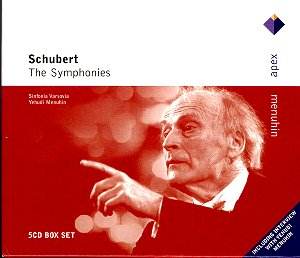A few years ago, I remember hearing a talk given
by William Boughton, the conductor and founder of the English
Sinfonia. He told a tale about Hungarian and other Eastern Bloc
ensembles being generally unable to stop themselves from racing
forward, unless reined in by a very insistent conductor. On the
evidence of this 4/5 disc set from Apex, Yehudi Menuhin is a conductor
who obviously likes to give an orchestra its head.
Including period performances, this is one of
the fastest played cycles of these glorious symphonies I have
ever heard. If it were not for the presence and timbre of modern
instruments, these readings would probably be praised as historically
accurate.
Schubert started writing symphonies at the tender
age of 16, and continued through his relatively short life whilst
at the same time pouring out many other works in all types: songs,
choral, chamber works, ballets etc. He produced some of the loveliest
vocal pieces ever written.
The First Symphony, written when the composer
was 16, is influenced by the then current masters of the form,
Haydn, Mozart and early Beethoven. These early works were produced
at a rate of one every year on average, quite impressive when
you consider everything else the composer was engaged in.
All of the early symphonies (1–4) were written
in major keys and are bright, tuneful works. They give much pleasure,
particularly when played as they are here, and recorded in clear,
and well balanced audio quality.
By the time we reach Number 5, Schubert appears
to be regressing to before Haydn and Mozart. He dispenses with
trumpets and drums, clarinets and second flute. With all of this
reduction, we end up with one of Schubert’s most popular symphonies,
showing once and for all that big is not necessarily beautiful.
Is this one of the first examples of minimalism?
No. 6 returns to the more normal forces with
the addition of the by now obligatory trombones. These were used
by other composers as the symphony became both more complex and
more noisy. We now see definite influences of Beethoven and also
of Rossini, who was all the rage at the time in Vienna.
Numbers 8 and 9 show Schubert’s mastery of the
symphonic form. These two last symphonies are often imbued with
an almost religious atmosphere by other conductors. Here they
are played again with all haste and vigour, which I find enormously
attractive.
This is a set to treasure, and to enjoy over
and over again. This is particularly true if you are sick of listening
to more sanctimonious performances which reduce the composer to
a museum piece. Here, we have a young vigorous artist, thoroughly
enjoying his mastery as a symphonic composer, played by an orchestra
and conductor who seem hell-bent on getting as much fun and freshness
out of this music as possible.
Highly recommended, particularly at the low price.
From the format of the set (i.e. with separate comprehensive notes
in each individual case) it would appear that these discs may
become available separately at a later date. This is of no matter
as they are all worth hearing.
John Phillips
